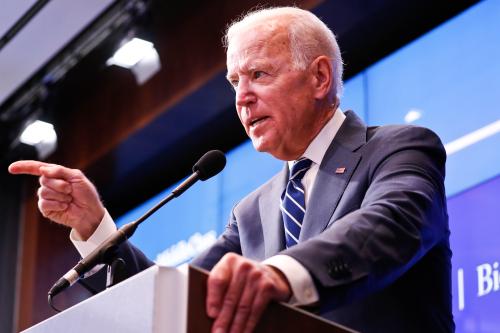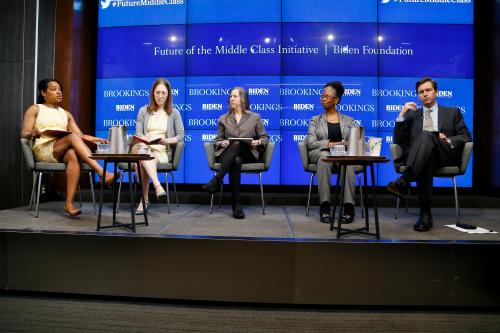This post originally appeared on the Biden Forum on May 16, 2018.
We worry a lot about the middle class: but who are they? Are you middle class? What does it really mean to be middle class in America today? As a recovering Brit and a new American, this is a question I struggle with. In my old country, it is easy. People with titles, the hereditary aristocracy, are the upper class. People without titles, but with plenty of money, are middle class. Everyone else is working class. Here in the U.S., it’s less clear cut. As I argue in a new Brookings paper, class can be defined along a host of dimensions: by economic resources; education and occupation status; or attitudes, self-perception, and mindset. Determining whether you are “middle class” requires different information for each of these three categories. For the first (cash), we need to see your bank balance. For the second (credentials) we need to see your résumé. For the third (culture), we need to see inside your head. Even among economists who define the middle class according to a household’s place in the income distribution, there is no agreement about what that income should be. The middle 20 percent of households? Middle 60 percent? Between 75 percent and 125 percent of the median income? How about 66 percent to 200 percent? Fifty percent to 150 percent? Wait, don’t stop reading yet: boring as these debates may sound, questions of definition really matter when it comes to describing the condition and outlook of the middle class. As economists Anthony Atkinson and Andrew Brandolini put it: “the arbitrariness of any delimitation of the middle class may lead to contradictory results”. This is one reason why some prefer to define middle-class status not by affluence but in terms of aspirations or values. Vice President Joe Biden falls into this camp. Here is what he said during a keynote address at a joint summit between the Biden Foundation and the Brookings Institution last week:
“Middle class is not a number. You can give me a number that says $51,251 or $52,000. But it is a value set. It is about being able to own your home and not have to rent it. It is about being able to send your kid to a park and you know they’re going to come home safely. It is about being able to send your kid to a school, a public school, that if they do well enough, they can go on after high school. And if they qualify to go on after high school, you can figure out how to pay for it. In the meantime, you can take care of your geriatric mom after your dad passed away.”
Of course, money matters here—money to buy a home, pay for college, and have the resources to care for the elderly parent. But money is not the essence of middle-class status. Being middle class is as much a mindset as a bank balance. It is about how you look at yourself, how you perceive our future, and how you are treated by others. The critical currency here is not economic resources, but respect. Respect for oneself, and mutual respect for each other. Class is then about respect and relationships, not just earnings and certificates. This is what the philosopher Philip Pettit means when he channels John Milton to argue that a truly equal society is one where everyone “can look each other squarely in the eye.” This idea of class as respect comes with its own problems of course, not least in the way that certain people can be denied respect simply on the grounds of their race. In a racist society, your right to look me in the eye as an equal depends on the color of your skin. Robert Wuthnow, in his book American Misfits and the Making of Middle Class Respectability, argues that certain groups—black Americans, squatters, “white trash”—serve in effect as contra-examples of middle-class lifestyles: “Marginalized individuals and groups served persistently, repeatedly, and often quite prominently as the contrasting cases, the negative comparisons through which middle-class respectability was defined.” Opening up the middle class means both fostering equal economic opportunity and pursuing racial equity. It’s a tall order. Respect is nonetheless a powerful lens through which to look at inequality. Scholars and policymakers tend to measure inequality in economic, educational or geographic terms. But there is a deeper gap underlying all of these: a respect gap. Americans of different classes seem to lack a certain degree of respect for one another. Too many of the upper middle class look down their noses at the working or middle classes, one reason why Hillary Clinton’s “deplorables” comment, no matter how much it was taken out of context, did such damage. American snobbery is every bit as vicious as the English kind I tried to flee some years back. The group that Trump called the “forgotten Americans” are now returning the favor, disparaging the white-collar professionals who run their companies, schools, and colleges. The very idea of an “expert” is increasingly sullied, a result of the rising inverse snobbery of many of those in the angry middle class. Restoring the fortunes of the American middle class is a policy challenge. It is a political challenge. And it is an economic challenge. But it is a cultural challenge, too. For a start, let’s start treating each other with a little more respect.





Commentary
How to build a stronger middle class: With respect.
May 21, 2018